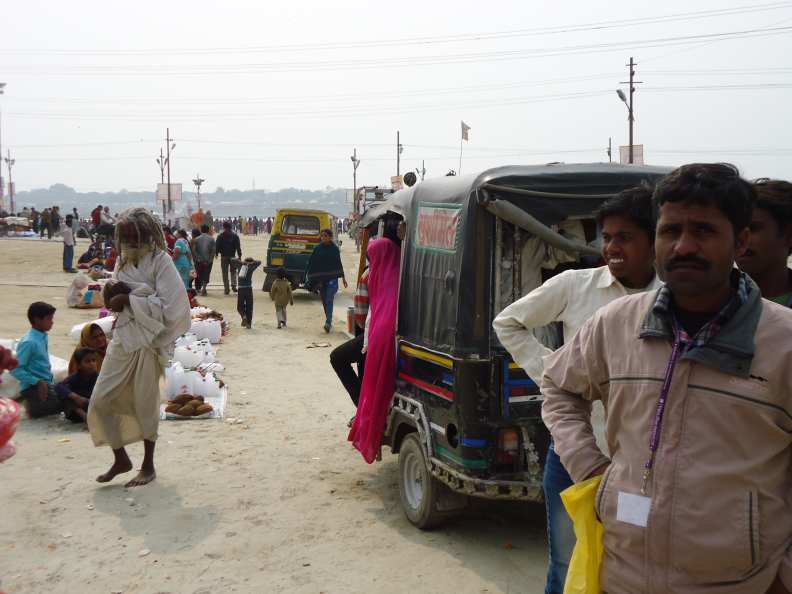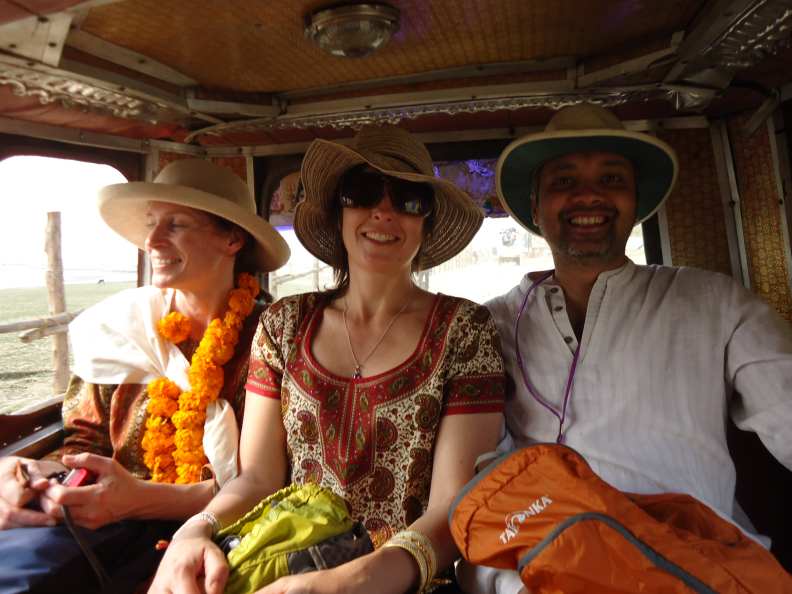AS PUBLISHED IN YOGA NATION
I always understood that I was coming on a pilgrimage when I signed up to come to the 2013 Kumbha Mela in Allahabad, India. I just didn’t know what part of this trip was going to be pilgrimage. Or even, perhaps, what a pilgrimage was.
On the road to the Kumbha Mela
I fantasized about meeting holy teachers who had descended from their reclusive, Himalayan caves—I had read about this in a newspaper article.
I dreamed of unexpected—but very enlightening—encounters with humanity on the dusty road to the great festival: After all, Parahamsa Yogananda famously met an incarnation of his teacher’s teacher at a Kumbha Mela in the early 20th century.
At the very least, I thought, the Himalayan Institute in Allahabad would invite some sages with whom they had personal connections to the campus for talks and maybe blessings, too. This was a long-awaited spiritual gathering of up to 100 million people, and I was traveling from so far away, after so much preparation—something had to happen.
On the road
I’ve been in Allahabad for 2 1/2 days now. On the first day, we were hauled (literally) up the Ganges on wooden boats til we reached the most auspicious place, the confluence of the Ganges and Yamuna rivers, as well as the mysterious Saraswati river that you can’t actually locate on any map.
Small, strong men rowed, punted (with long bamboo poles), and pulled us with string. The boat traveled against the current, under makeshift pontoon bridges, dodging garbage and sand bars, until we reached the sangam, the meeting of the waters. There, we blessed ourselves by scooping up handfuls of the highly toxic river (E.coli levels at 100x what’s acceptable), saying a prayer, then sprinkling the auspiscious water over our heads—and liberally dousing with hand sanitizer afterwards.
It seemed like cruel labor for the men until we were informed that their previous cargo had been SAND (sand from the Ganges is highly prized by cement factories).
Still, nothing happened. But no worries, I thought, tomorrow we are going into the Kumbha Mela for real, finally reaching a destination that I have been thinking about for 3 years. With 8 square miles and countless sadhusprominently dressed in orange robes, something was bound to happen.
I set out with Stewart, my new Glaswegian friend. We were so deep in conversation about the pilgrimage itself that we hardly noticed the piles of fine white sand that our feet were kicking up. Soon our mouths were full of sand, and any exposed skin slathering in sunscreen was covered, too. I noticed local women were holding the ends of their saris over their mouths.
Kumbha Mela road is dusty, muddy, and hot
It was the tremendous noise that stopped our conversation. Singers, chanters, proclaimers and lecturers projected at top volume through cheap loudspeakers. Meanwhile rickshaws, motorcyles, bicycles, and Mercedes Benz jeeps (full of sadhus in orange robes) honked and whistled and rang on either side of us. We couldn’t hear anything else.
We caught up with other people from the Himalayan Institute at a fork in the road: now we would go down into the mele, and maybe cross a pontoon bridge to the Kumbha Mela grounds on the other side of the Ganges.
Anyway, anyhow
We added Ali and Mangesh from London, also Selina an English nurse transplanted to America to our two-some, and together headed down towards the sangam, the confluence. This time from the land.
Along the way, we browsed bangle shops, haggled for malas (since Mangesh speaks Hindi), took photos and generally wondered what was going on inside all the tent camps that lined the makeshift road. That’s where, supposedly, the sages held court.
Often, as we took our pictures, a small crowd would gather to take photos of us. It seemed fair, although it was weird. Or a sage would stop and, with a kindly expression, stand a little too close and stare at us with unblinking eyes.
A baba
After a packed lunch of potato chips, pakoras, and (fake) mango juice-boxes we visited the bathing areas that faced the sangam. Here, whole families and villages were bathing in the holy river, the Ma Ganga. Selina was excited to immerse herself, but I wasn’t interested in getting closer to the bacteria.
Bathing in the Ganges
Mangesh did buy a boat of flowers and sent it out into the waters. (It flowed right back in, and Ali made fun of him.)
Flower boats
And then we had to admit that we were hot, still hungry, tired, and ready to go back to the campus. Which seemed a long ways away at that point. We were done and we still hadn’t really encountered that thing that was supposed to happen.
We were just tourists wandering in a fair ground, surrounded by thousands of people elaborately wrapped in gorgeous colors, or lining the roads trying desperately to eke out a living.
Entrance to a sadhu’s tent camp
The language barrier made it so that we would never really understand whose tent camp we were passing, which ones to go in, and which ones to avoid. They all looked as if they could swallow us up whole, exotic as we were with our very pale skin. Even Mangesh, who is Indian, couldn’t understand what we were seeing.
Tired from the dust, the noise, the heat, and the more-or-less aimless wandering in search of the fulfillment of Our Pilgrimage, we turned back.
“Are you feeling the auspicious energy, or anything?” asked Ali, former IT guy for a London investment bank.
“Not really,” I said. “I mostly feel tired.”
There were some silent, tired nods around our little group.
At last, we picked a tent camp at random and stopped in. The less digestively-challenged of us accepted the free meal being offered, sitting back to back on the ground with Indian pilgrims who presumably did know why they were here and what they were supposed to be doing.
On the way back, I suggested a rickshaw. Mangesh haggled a price and we dove in—Selina, Ali, Mangesh and me. We picked up Stewart who had booked it on ahead of us. He looked very pleased when we pulled up.
Stewart and Ali in the rickshaw
“The Ganges is inside you,” said a senior Himalayan Institute teacher. “Don’t get caught up in whether you immerse yourself or not. Notice her qualities, how the river flows, how constant and abundant she is. This is what you want to connect to. The vitality, the power.”
“There are so many political factions at the Kumbha Mela,” said another teacher later over chai, “And in India politics and religions are completely mixed together, no separation. There are serious lobbyists working the Kumbha Mela. It’s all over our heads. Sure, there are some very accomplished holy teachers in there, but the chances of us figuring out who’s who are slim. Even so, we’re all here at an auspicious time, doing our own practice, and that’s the benefit. The Mela is not the benefit, it’s your own practice.”
The rickshaw ride back was wonderful. Back on campus, we bathed from buckets in straw huts equipped with clean water. I didn’t care how simple it was—the water, the quiet, and the afternoon breeze felt as “authentic” and “auspicious” as anything ever had.
The circus wasn’t the point: the point was—as it always is— all within.
Selina, JH, Mangesh











